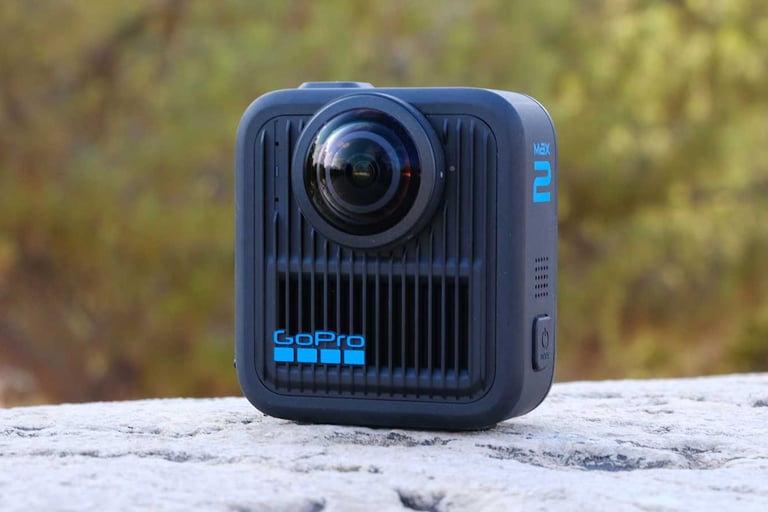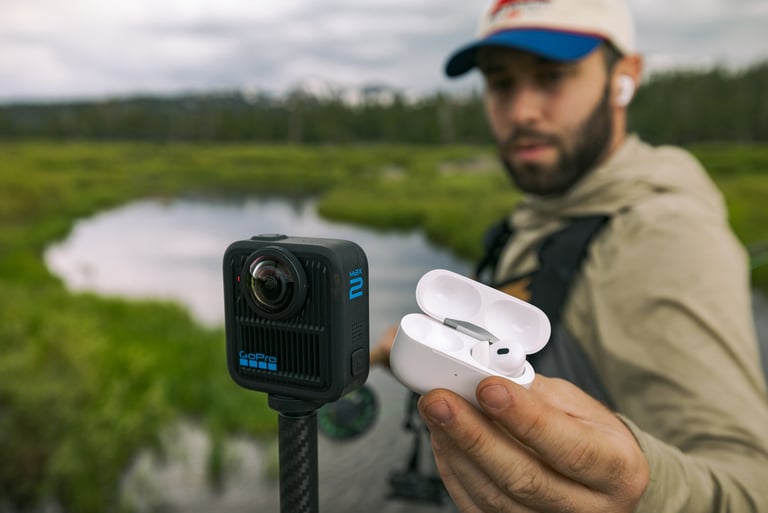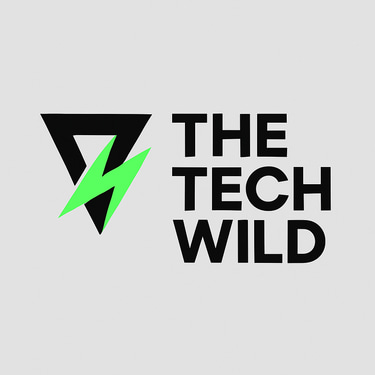GoPro's Max 2 promises 'true 8K' 360-degree video to take on DJI and Insta360
GoPro's new flagship 360-degree camera promises authentic 8K recording without upscaling, featuring replaceable lenses and enhanced durability. Available for $499.99, the Max 2 challenges Insta360 and DJI with superior resolution but limited battery life in 8K mode.
Subodhya Fernando
9/25/20256 min read
The action camera maker claims its new flagship 360-degree camera delivers higher resolution than the competition
The 360-degree action camera maker claims its new flagship 360-degree camera offers superior resolution compared to other makers
The Max 2 marks GoPro's comeback to the 360-degree industry after a five-year hiatus with no product since the release of the original Max in 2019. Insta360 dominated the 360-degree camera landscape in the meantime, and DJI joined this entire-capture camera market with its own strong products in recent times. GoPro is relying on improved image quality and reasonable design upgrades to catch up lost territory in this increasingly saturated market.
This isn't a minor incremental update. The Max 2 represents GoPro's recognition of how the market for 360-degree cameras has moved beyond hobbyists and early adopters and into mainstream as a professional creator, social media influencer, and corporate tool to make immersive experiences. More is at stake now, so are expectations. What makes the 8K "true"
GoPro's biggest selling point is that it claims to offer actual 8K resolution, not upscaling or artificial enhancement. The company emphasizes "no misleading upscaling, no unusable black pixels, no AI-generated content reproductions, just 8K 360° video." Two of the image sensors are coupled with excellent stitching to offer 29 million pixels and what GoPro considers actual 8K resolution.
What makes the 8K "true"
GoPro's main selling point is its claim to deliver authentic 8K resolution without upscaling or artificial enhancement. The company emphasizes "no misleading upscaling, no unusable black pixels, no AI-generated content reproductions, just 8K 360° video." Two powerful image sensors combine with premium stitching quality to deliver 29 million pixels and what GoPro calls true 8K resolution.
In practical terms, this means you have more usable picture area in 360-degree mode, where there are essentially two circular fields of view with unusable black space in between. The result should be noticeably sharper footage compared to competitors that rely on upscaling techniques or interpolation to achieve their "8K" specifications.
The technical implementation involves dual fisheye lenses capturing overlapping fields of view, which are then seamlessly stitched together using advanced algorithms. GoPro claims its stitching technology has been refined to minimize artifacts and distortion at the seam lines, a common weakness in 360-degree cameras where the two images meet.
Beyond 8K, the Max 2 offers impressive versatility with 5.6K video at up to 60fps and 4K at up to 100fps, along with 10-bit color depth and GP-Log encoding for professional color grading workflows. For professionals, the Max 2 can record in 10-bit color for over one billion colors of dynamic range, capture 29-megapixel 360-degree photos, and achieve 300Mbps bitrate recording with a "GoPro Labs" firmware update.
Practical improvements that matter
One of the Max 2's most notable features addresses a common pain point that has plagued 360-degree cameras: lens damage. The camera includes twist-and-go replaceable lenses, ensuring that creators can always capture clear shots, even if their lens gets scratched or cracked during extreme activities. This user-serviceable design eliminates the frustrating and expensive process of sending the camera for professional repair when lenses get damaged.
This feature alone could be a game-changer for adventure sports enthusiasts and professional creators who can't afford downtime. Previously, a scratched lens meant either living with compromised image quality or being without the camera for weeks during repair. Now, users can carry spare lenses and swap them out in seconds.
The Max 2 also includes several other practical upgrades that demonstrate GoPro's attention to real-world usage scenarios. The camera features six built-in microphones strategically positioned to capture immersive spatial audio that matches the 360-degree visual experience. This multi-microphone array is crucial for virtual reality applications and professional productions where audio quality can make or break the immersive experience.
Battery life receives significant attention with a larger 1,960mAh "Enduro" battery specifically designed for cold weather performance. GoPro has long struggled with battery performance in extreme conditions, and the Enduro battery represents a focused effort to address this limitation. The Max 2 is also the only 360-degree camera in its class with built-in GPS, enabling automatic location tagging and advanced stabilization features.
The camera is compatible with over 35 mounts and accessories, giving users extensive mounting options for different shooting scenarios. This ecosystem approach has always been one of GoPro's strengths, and the company is leveraging this advantage in the 360-degree space.
Performance and real-world limitations
Early feedback suggests the Max 2 delivers on image quality promises but with sacrifices in the process. The camera brings with it a major resolution boost from its 5.6K successor in the form of full 8K and 10-bit color depth. Early feedback reveals GoPro's Max 2 to be indeed a serious contender against DJI and Insta360, with image quality being a major focus and efficient editing features designed to help users create content they'll actually publish.
The high-resolution capture is, nonetheless, at the cost of battery life, an eternal thorn in the side of the action camera industry. Capture using 8K footage enabled, the Max 2 only lasts around 30 minutes before shutting down due to battery drain. Capture using 5.6K footage provides greatly improved performance at nearly 58 minutes under identical conditions. Temperature is another factor to consider, as reduced temperatures can help increase recording time while overheat prevents performance.
Thermal management is also an issue. Like with most high-res cameras, the Max 2 might experience thermal throttling on long recording sessions, particularly in warm temperatures. GoPro has implemented thermal management systems, yet users who plan to use it for extended recording sessions must be mindful of potential limitations.
The flat, low-profile design of the camera is more suitable for helmet and body mounting applications than blocky rivals, but this reduced volume also limits surface area for thermal dissipation and less battery capacity than other higher-volume choices provide.
The competitive landscape and market dynamics
The Max 2 enters into a market that has significantly altered since GoPro's last 360-degree camera. Insta360 has had its dominance with a wide range of products from consumer-level models to pro cameras. The firm has increasingly innovated with aspects like AI editing, top-end stabilization, and groundbreaking modes for recording.
DJI's entry into the 360-degree market has increased competition even more. The manufacturer of drones utilizes their background in imaging technology and stabilization systems, creating intriguing alternatives that appeal to both enthusiasts and professionals.
GoPro's approach seems to be to differentiate on higher image quality and functional features such as swappable lenses, instead of price competition or novelty features. The company is betting that creators will pay for real 8K recording and field-serviceable hardware over more flash but less functional innovation.
The 360-degree camera market itself has matured quite a bit, with applications beyond action sports into real estate, education, virtual travel, and social media video production. That broader appeal puts more pressure on creators and demands more sophisticated, more reliable products.
Looking ahead: GoPro's 360-degree gambit
The Max 2 is GoPro's return to the 360-degree market after years of permitting others to establish dominant positions. The emphasis on "true 8K" resolution and functional innovations like exchangeable lenses suggests a grown understanding of what creators actually need versus what's buzz-worthy in marketing fluff.
Achieving success with the Max 2 diversifies GoPro's product line away from its standard action-camera products and accesses growing demand for immersive content creation. Virtual reality development, augmented reality applications, and social media 360-degree content create expanding opportunities for specialized cameras.
That being said, GoPro has some stiff competition. Insta360 and DJI both have years of experience honing their products, building developer relationships, and creating distribution channels. Both of them have an established history of innovation and devoted customers. GoPro will need to show that its approach delivers real benefits for practical users, not just impressive specs.
The Max 2 is available for pre-order today for $499.99 and will start shipping on September 30, 2025. Either success or failure here will prove to be what makes or breaks GoPro's opportunity to regain standing in the market for 360-degree cameras, or whether it has waited too long and will be left scrambling against established players. For artists, the Max 2 is another robust option in an increasingly sophisticated market where true winners are consumers who benefit from increasing competition and rapid progress.




